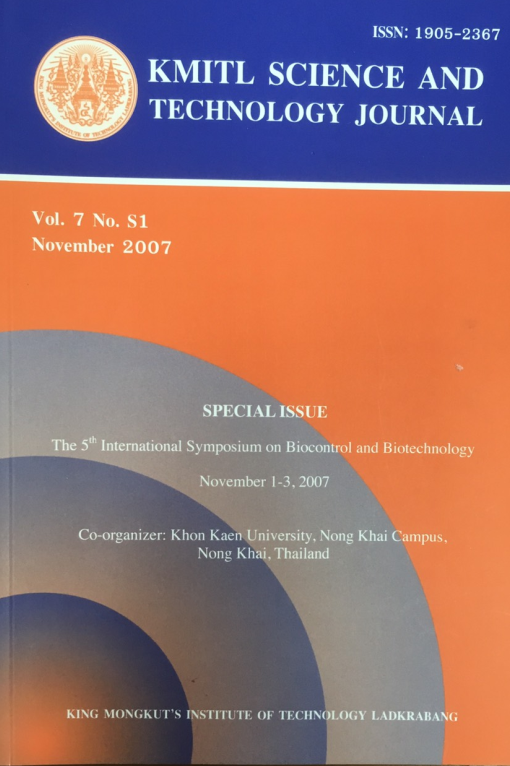ANTIOXIDANT ACTIVITY OF Padina minor YAMADA
Main Article Content
Abstract
A brown alga, Padina minor Yamada (division Phaeophyta), collected from Naiyang beach, Phuket province, Thailand was examined for antioxidant properties. The aqueous extract of P. minor showed radical scavenging activity of 864.71 ± 19.75 mg gallic acid equivalent (GAE) and 0.567 ± 0.004 µM Trolox equivalent (TEAC) when tested by the DPPH (1-diphenyl-2-picrylhydrazyl) and ABTS•+ (2,2’-azino-bis 3-ethylbenzthiazoline -6-sulfonic acid cation) assays, respectively. Additionally, the extract inhibited lipid peroxidation of rat liver (0.052 ± 0.001 mM TEAC). Total phenolic content of the extract was found to be 217.40 ± 11.28 mg GAE. The antioxidant activities of P. minor indicate its potential role as nutraceutical and cosmeceutical products.
Keywords: Padina minor, DPPH, ABTS˙+, lipid peroxidation, phenolic content, anti-oxidant activity
Corresponding author: E-mail: doung_prim@yahoo.com
Article Details
Copyright Transfer Statement
The copyright of this article is transferred to Current Applied Science and Technology journal with effect if and when the article is accepted for publication. The copyright transfer covers the exclusive right to reproduce and distribute the article, including reprints, translations, photographic reproductions, electronic form (offline, online) or any other reproductions of similar nature.
The author warrants that this contribution is original and that he/she has full power to make this grant. The author signs for and accepts responsibility for releasing this material on behalf of any and all co-authors.
Here is the link for download: Copyright transfer form.pdf
References
[2] Yubin, Ji., and Guangmei, Z. 1998 Pharmacological action and application of available antitumor composition of traditional Chinese medicine. Heilongijang, China: Heilongjiang Science and technology Press.
[3] Fitton J. Helen. 2003 Brown marine algae: A survey of therapeutic potentials, Alternative and Complementary Therapies. February, 29-33.
[4] Lee, J., Koo, N. and Min D.B. 2004 Reactive oxygen species, aging, and antioxidative nutraceuticals, Comprehensive Review Food Science and Food Safety, 3, 21-23.
[5] Middleton, E., Kandaswamy, C. and Theoharides, T.C. 2000 The effects of plant flavonoids on mammalian cells: Implications for inflammation, heart disease, and cancer, Pharmacological Reviews, 52, 673-751.
[6] Brash, D.E. and Harve, P.A. 2002 New careers for antioxidants, Proceedings of the Nationall Academy of Science of the United State of America, 99, 13969-13971.
[7] Madhavi, D.L. and Salunkhe, D.K. 1995 Ed. Toxicological aspects of food antioxidants. In: D.L. Madavi, S.S. Deshpande and D.K. Salunkhe, Ed. Food Antioxidants. Dekker, New York, pp. 1995, 267.
[8] Yan X, Nagata T, Fan X. 1998 Antioxidative activities in some common seaweeds, Plant Food for Human Nutrition, 52 (3), 253-262.
[9] Lim SN, Cheung PC, OoiVE, Ang PO. 2002 Evaluation of antioxidative activity of extracts from a brown seaweed, Sargassum silliquastrum, Journal of Agricultural and Food Chemistry, 50 (13), 3862-3866.
[10] Hou, W.C., Y.C. Chen, H.J. Chen, Y.H. Lin, L.L. Yang, and M.H. Lee. 2001 Antioxidant activities of trypsin inhibitor, a 33 kDa root storage protein of sweet potato (Ipomoea batatas (L.), Journal of Agricultural and Food Chemistry, 49, 2978-1981.
[11] Re, R., Pellegrini, N., Pannala, A., Yang, M. and Rice-Evan, C. 1999 Antioxidant activity n decolorisation assayapplying an improved ABTS radical catio, Free Radical Biology and Medicine, 26 (9/10), 1231-1237.
[12] Masao H, Yang HW, Miyashrio H and Nabma T. 1993 Inhibitory effects of monomeric and dimeric phenyl propanoids from mice on lipid peroxidation in vivo and in vitro, Phytotherapy Research, 7, 95-401.
[13] Hammerschmidt, P.A. and Pratt, D.E. 1978 Phenolic antioxidants of dried soybeans, Journal of Food Science, 43 (2), 556-559.
[14] Piao, X.L., Park, I.H., Baek, S.H., Kim, H.Y., Park, M.K. and Park, J.H. 2004 Antioxidative activity of furanocoumarins isolated from Angelicae dahuricae, Journal of Ethnopharmacology, 93, 243-246.
[15] Yu, L., Haley, S. J., Perret, M. Harris, Wilson J. and Qian, M. 2002 Free radical scavenging properties of wheat extracts, Journal of Agricultural and Food Chemistry, 50, 1619-1624.
[16] Leong, L.P. and Shui, G. 2002 An investigation of antioxidant capacity of fruits in Singapore markets, Food Chemistry, 76, 69-75.
[17] Cheeseman, K.H. and Holley, A.E. 1993 Measuring free radicals reaction in vivo, British Medical Bulletin, 49, 491-505.
[18] Halliwell, B., Gutteridge, J.M.C. and O.I. Aruoma, J.M.C. 1987 The deoxyribose method: a simple test tube assay for determination of rate constants for reactions of hydroxyl radicals, Annual Biochemistry, 165, 215-219.
[19] Lewis, N.G., Alscher, R.G. and Hess, J.L., 1993 Ed. Antioxidants in higher plant. Boca Raton, FL, CRC Press, pp. 135-169.
[20] Yen, G.C., Duh, P.D. and Tsai, C.L. 1993 Relationship between antioxidant activity and maturity of peanut hulls, Journal of Agricultural and Food Chemistry 41, 67-70.


